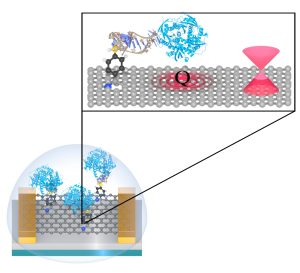Biosensors based on graphene field-effect transistors have become a promising tool for detecting a broad range of analytes. However, they lack the stability and reproducibility required to step into biotechnological and biomedical applications. ESISNA group has used a promising physical graphene functionalization protocol which allows atomically-precise highly-controlled covalent functionalization, preserving all the graphene properties, to develop a graphene solution gated field-effect transistor (g-SGFET) aptasensor, with a high affinity DNA aptamer specifically synthesized able to detect the hepatitis C virus (HCV) core protein. These devices are highly specific and robust, achieving attomolar detection of the viral protein target in buffer and in human blood plasma. Their improved sensitivity is rationalized by ab-initio calculations that show a negligible charge injection to the graphene, while the induced polarization at the graphene interface is significantly enhanced by an antenna-like effect induced by the covalently bound molecule leading to a net movement of the Dirac cone at short distances. Such an unexpected effect together with the versatility of the functionalization protocol, paves the way for using this kind of graphene-based platforms for real-time diagnostics of different diseases.

You can find the work published in open access in:
Attomolar detection of hepatitis C virus core protein powered by molecular antenna-like effect in a graphene field-effect aptasensor,
I. Palacio, M. Moreno, A. Náñez, A. Purwidyantri, T. Domingues, P. D. Cabral, J. Borme, M. Marziello, J. I. Mendieta-Moreno, B. Torres-Vázquez, J. I. Martínez, M. F. López, M. García-Hernández, L. Vázquez, P. Jelinek, P. Alpuim, C. Briones, J. A. Martín-Gago,
Biosens. Bioelectron., 222, 115006 (2023).
A patent based on this work has been applied for (Ref: PCT/EP2022/071173).

